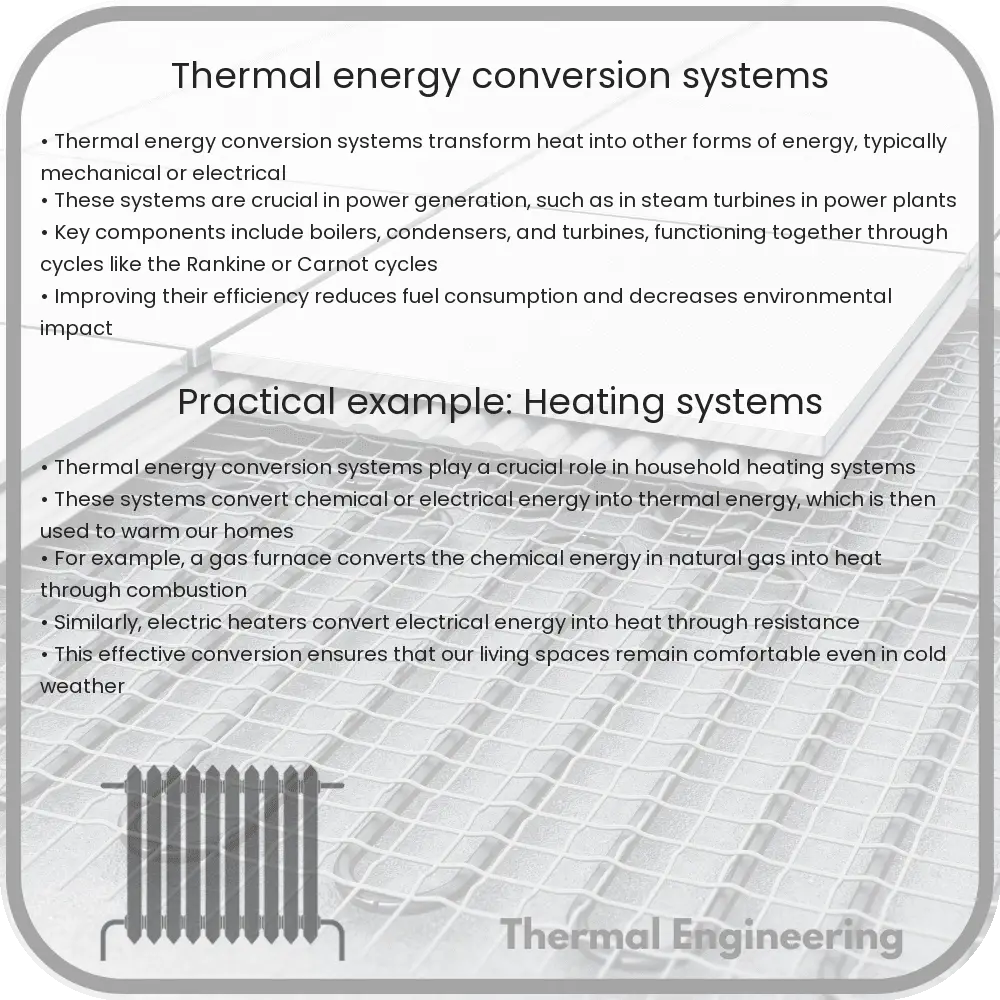Comprehensive guide on thermal energy conversion systems, covering key types, components, and applications for efficient power generation.

Understanding Thermal Energy Conversion Systems
Thermal energy conversion systems are crucial for harnessing energy from heat sources and converting it into usable power, typically electricity. This concept is pivotal in various applications, ranging from large-scale power generation to small-scale applications like automotive engines. This article will explore the basic principles of thermal energy conversion systems, including their types, components, and applications.
Types of Thermal Energy Conversion Systems
There are several types of thermal energy conversion systems, each differing by the source of heat and the method of conversion:
- Steam Turbines: Widely used in power generation, steam turbines convert high-pressure steam, produced from boilers or heat recovery steam generators, into mechanical energy that drives generators to produce electricity.
- Internal Combustion Engines: Common in automotive applications, these engines burn fuel to create high-temperature gas that expands and pushes against the engine’s pistons, producing mechanical power.
- Thermoelectric Generators: These devices directly convert heat into electricity using the Seebeck effect, where a temperature difference between two dissimilar electrical conductors or semiconductors produces a voltage difference.
- Stirling Engines: These operate by cyclic compression and expansion of air or other gas at different temperatures, resulting in a net conversion of heat energy to mechanical work.
Key Components of Thermal Energy Conversion Systems
Although varying significantly in design, most thermal energy conversion systems share common key components:
- Heat Source: Provides the essential high-temperature energy needed for the process. This could be from burning fuels, nuclear reactions, solar heat, or residual heat from industrial processes.
- Converter: The mechanism that actually converts the heat energy into mechanical or electrical energy. For instance, turbines, engines, or thermoelectric modules.
- Cooling System: Essential for condensing steam in turbines or cooling other components, maintaining operational efficiency and safety.
- Generator: In systems producing electricity, the generator converts mechanical energy into electrical energy.
Application of Thermal Energy Conversion Systems
The applications of thermal energy conversion systems are vast and varied:
- Power Plants: The most common application, where large steam turbines are used to generate electricity from nuclear, coal-fired, or gas-fired power plants.
- Automobiles: Internal combustion engines power most vehicles by converting the chemical energy of fuel into mechanical energy.
- Remote Power Supply: Thermoelectric generators are often used in remote or small-scale applications where traditional power grids are unavailable.
- Waste Heat Recovery: Systems that capture and convert waste heat from industrial processes can significantly increase efficiency and reduce energy consumption.
Improving Efficiency and Sustainability
Efficiency improvements and sustainability are critical challenges in the design and operation of thermal energy conversion systems. Techniques such as combined heat and power (CHP), which utilizes both the mechanical and thermal energy produced by these systems, are becoming increasingly important. Reducing environmental impact, optimizing fuel use, and integrating renewable energy sources are ongoing areas of research and development in this field.
In conclusion, thermal energy conversion systems play a pivotal role in modern energy landscapes. Understanding the fundamental principles, components, and applications of these systems provides a foundation for appreciating how essential they are to our daily lives and future energy sustainability.